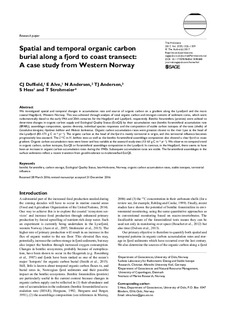| dc.description.abstract | We investigated spatial and temporal changes in accumulation rate and source of organic carbon on a gradient along the Lysefjord and the more coastal Høgsfjord, Western Norway. This was achieved through analysis of total organic carbon and nitrogen content of sediment cores, which were radiometrically dated to the early 19th and 20th centuries for the Høgsfjord and Lysefjord, respectively. Benthic foraminifera (protists) were utilized to determine changes in organic carbon supply and Ecological Quality Status (EcoQS) by their accumulation rate (benthic foraminiferal accumulation rate (BFAR)), assemblage composition, species diversity, individual species responses and the composition of stable carbon isotopes of the tests (shells) of Cassidulina laevigata, Hyalinea balthica and Melonis barleeanus. Organic carbon accumulation rates were greatest closest to the river Lyse at the head of the Lysefjord (83–171 g C m−2 yr−1). The organic carbon at the head of the fjord is mainly terrestrial in origin, and this terrestrial influence becomes progressively less seaward. The δ13C in H. balthica tests as well as the benthic foraminiferal assemblage composition also showed a clear fjord to coast gradient. Organic carbon accumulation rates were lower and less variable at the seaward study sites (13–61 g C m−2 yr−1). We observe no temporal trend in organic carbon, carbon isotopes, EcoQS or foraminiferal assemblage composition in the Lysefjord. In contrast, in the Høgsfjord, there seems to have been an increase in organic carbon accumulation rates during the 1940s. Subsequent accumulation rates are stable. The foraminiferal assemblages in the surface sediments reflect a recent transition from good/moderate to moderate/bad EcoQS. | nb_NO |
